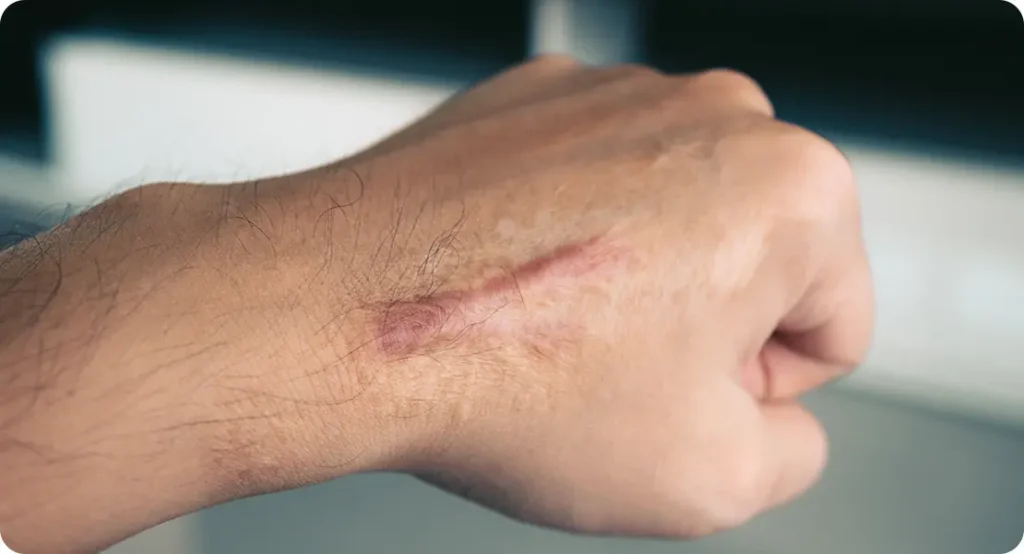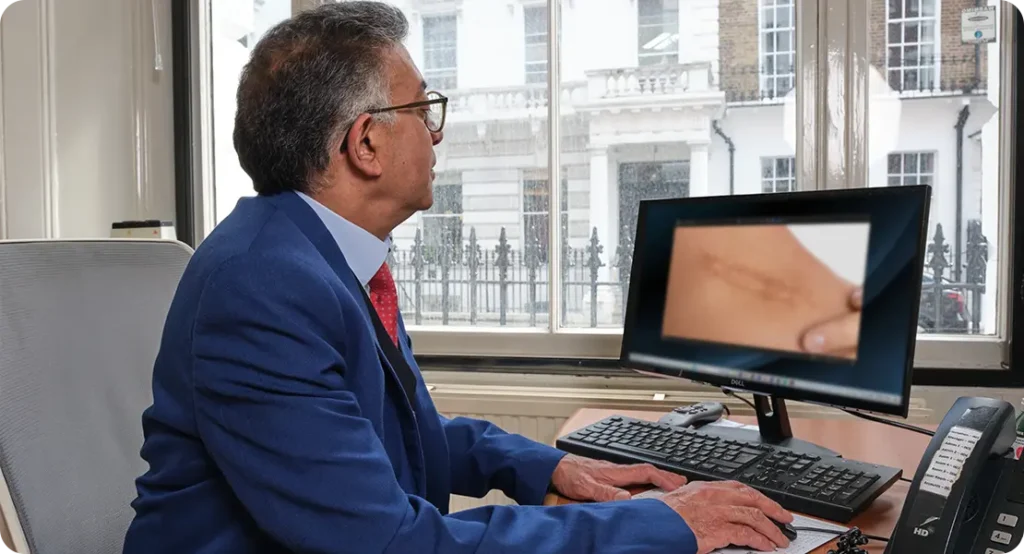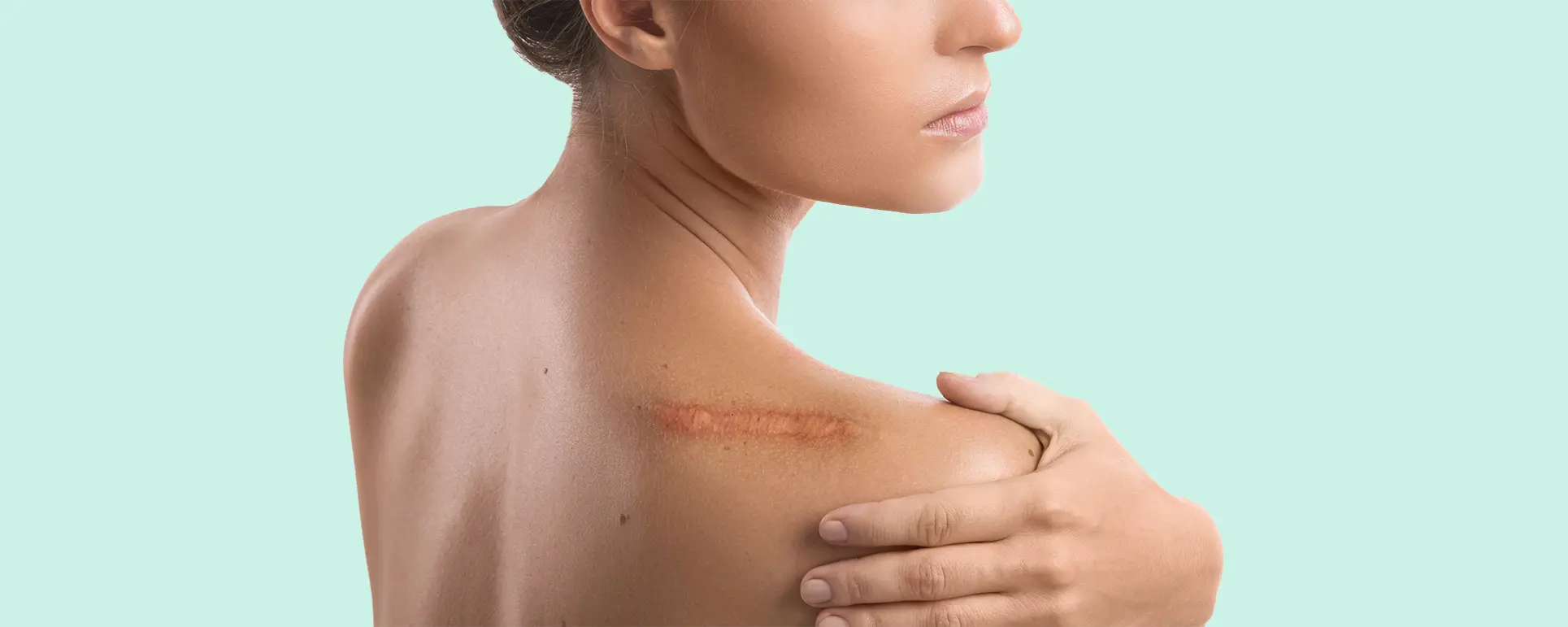Most of us assume that scars will naturally fade away with time. A small cut, minor burn, or surgical incision goes through its usual healing stages, the skin gradually knits back together, and eventually, the mark becomes faint or barely noticeable or at least that’s what we expect. In many cases, this is exactly what happens. But what if your scar doesn’t follow the usual path?
If your scar remains red, raised, itchy, or even painful for several months or if it seems to be getting worse rather than better it could be a sign that something isn’t quite right with the healing process. While every scar is unique and healing times can vary, prolonged or unusual symptoms are often a clue that your skin may need some extra support or professional evaluation.
Some degree of scarring is a normal part of your body’s repair system. However, when a scar looks abnormal or doesn’t improve over time, it may point to delayed healing, underlying infection, or an overactive healing response that leads to abnormal scar types like keloids or hypertrophic scars. These types of scars can become raised, tight, or uncomfortable and sometimes even interfere with movement depending on their location.
In some cases, poor wound care, underlying health conditions such as diabetes or autoimmune disorders, or even your genetic background can influence how your body heals. Factors like your skin tone, age, and how much sun exposure the area gets can also impact how a scar fades or doesn’t. Even things like smoking or picking at scabs during the healing process can increase the risk of poor outcomes.
Knowing what’s typical during scar healing and what falls outside the norm can help you make more informed choices about your skin. The good news is that abnormal scarring isn’t something you just have to live with. There are plenty of treatment options available, and the sooner you seek help, the better the results often are.
In this article, we’ll walk you through how scars usually heal, the warning signs to watch for, and when it’s time to consider professional advice. Whether your concern is cosmetic or medical, understanding your scar is the first step toward getting the right care.
What Normal Scar Healing Looks Like
When your skin is injured whether through a cut, surgery, burn, or scrape it immediately begins a complex healing process. Scarring is a natural part of this process. Although scars are permanent to some degree, most will fade and become less noticeable over time. Understanding what’s typical can help you avoid unnecessary worry and spot any signs of trouble early on.
In the initial days and weeks, a new scar usually appears red or pink. This is completely normal and is caused by increased blood flow to the area as your body delivers healing nutrients and immune cells. The skin around the scar may also feel slightly raised, firm, or tight as collagen production ramps up. Collagen is the protein responsible for rebuilding your skin’s structure after injury.
As the weeks go by, a healthy scar gradually becomes flatter, softer, and lighter in colour. It may shift from pink to a light brown or silvery tone, depending on your natural skin tone and how deep the injury was. You might experience some mild itching or sensitivity during this period, especially if the scar is over a joint or a mobile area of your body. This is usually nothing to worry about and tends to resolve on its own.
Normal scars typically don’t hurt after the initial wound has closed, and any tightness or stiffness tends to ease up as healing progresses. The entire process of scar maturation can take anywhere from a few weeks to over a year, depending on the size and depth of the wound, your skin type, and how well you care for the affected area.
Common signs of normal scar healing include:
- Slight redness or pinkness that gradually fades with time
- Itching or mild discomfort in the first few weeks (a sign of regenerating nerves and skin cells)
- Flattening and softening of the scar as collagen remodels
- Shrinking in size, becoming less prominent and blending more with the surrounding skin
- No significant pain, swelling, or fluid leakage after the wound has closed
While early-stage scars often look worse than they are, patience is key. The appearance of a scar in the first month isn’t a reliable predictor of how it will look a year later.
Signs That a Scar Isn’t Healing Properly
Not all scars follow a smooth or predictable healing path. While many heal quietly and gradually improve with time, others may take a detour developing complications that can affect both appearance and comfort. Sometimes, the issue stems from an external factor like infection or poor wound care. Other times, it’s your body’s unique healing response that causes the scar to form abnormally. Either way, it’s important to know the warning signs that indicate a scar might not be healing as it should.
Early recognition can make all the difference. Addressing these problems promptly can improve long-term outcomes and reduce the risk of more severe scarring.
Red flags to watch for include:
- Pain or swelling beyond the initial healing phase
Some tenderness is normal in the days following an injury or surgery. However, if pain or swelling continues for several weeks or suddenly returns after a period of improvement it could signal an underlying issue such as infection, internal inflammation, or even nerve involvement. Healthy scars usually settle down over time; worsening discomfort is not typical. - A thick, raised, or shiny surface
If your scar becomes noticeably elevated, firm, and glossy, you may be developing a hypertrophic scar or a keloid. These are forms of excessive scar tissue caused by overproduction of collagen. Hypertrophic scars stay within the original wound boundary, while keloids often grow beyond it. Both can be itchy, uncomfortable, and cosmetically concerning. They’re more common in individuals with darker skin tones or a family history of abnormal scarring. - Dark discolouration or widening of the scar
While some redness is expected early on, scars that become unusually dark (hyperpigmented), develop a purple or bluish hue, or begin spreading sideways may not be healing properly. A widening scar may suggest excessive tension on the skin or poor collagen organisation during healing. Hyperpigmentation can result from sun exposure, especially in people with melanin-rich skin. - Persistent itching, burning, or heightened sensitivity
Itching is common during the healing process, especially in the early weeks. But if it becomes constant, severe, or is accompanied by a burning sensation or hypersensitivity, it may point to nerve involvement or abnormal scar development. In some cases, these symptoms can interfere with sleep or daily comfort, making treatment even more important. - Fluid, crusting, or unusual changes in texture
If your scar oozes fluid, forms a persistent scab, or feels hot or tender to the touch, it may be infected. Bacterial infections can significantly delay wound healing and increase your risk of more severe scarring. Scars should remain dry and gradually smooth out not stay moist, crusty, or irritated. - Limited mobility or discomfort when moving
If the scar is located near a joint or over a highly mobile area (like the neck, knees, or elbows), abnormal healing can sometimes cause contractures tight bands of scar tissue that reduce flexibility and range of motion. This is more common in burn scars or large wounds, and it may require intervention such as physiotherapy or scar release treatment.
Possible Causes of Delayed Scar Healing

When a scar doesn’t seem to be healing properly, it’s easy to blame the wound itself but there’s often more going on beneath the surface. Delayed or abnormal scar healing can be influenced by a range of internal and external factors. Sometimes it’s due to the nature of the injury, such as its depth or location. Other times, it’s a result of how your body responds to the healing process or what happens during recovery.
Understanding the most common causes of delayed scar healing can help you identify what might be slowing things down and take steps to address it early.
Common causes include:
- Repeated trauma or irritation to the area
If your scar is located in a spot that gets bumped, stretched, rubbed by clothing, or moved frequently (like joints or waistbands), healing can be disrupted. Repeated physical stress can reopen fragile tissue, delay collagen remodelling, and increase the chance of raised or widened scars. Even simple habits like scratching an itchy scar or picking at a scab can hinder progress. - Infections during the healing process
Bacterial infections are a major reason scars don’t heal properly. When harmful microbes enter the wound especially in the early stages it can lead to swelling, pus, delayed closure, and more aggressive scarring. Infections trigger an inflammatory response that slows down healing and often results in a darker, thicker, or more irregular scar. - Underlying health conditions
Conditions like diabetes, anaemia, or autoimmune disorders can all impair wound healing. Poor blood sugar control, for instance, can reduce circulation and oxygen delivery to the skin both of which are essential for tissue repair. Similarly, people with vascular problems or low immune function may find their scars take significantly longer to settle. Even chronic stress or nutritional deficiencies can have a subtle but significant impact. - Genetics and skin type
Some people are simply more prone to abnormal scarring due to their genetic makeup. If you have a family history of keloids or thick scars, you may be at higher risk of developing similar issues. Additionally, people with darker skin tones tend to produce more melanin, which can lead to post-inflammatory hyperpigmentation a darkening of the scar after healing. Genetics can also affect how your body produces and remodels collagen, which plays a key role in scar formation. - Sun exposure during healing
UV rays can worsen scar appearance by increasing pigmentation and slowing down tissue regeneration. A healing scar is more vulnerable to sun damage than healthy skin, so exposure during this time can make the mark more noticeable and harder to treat later. - Improper wound care
Not cleaning a wound properly, leaving it uncovered too long, or using the wrong ointments can affect healing outcomes. The right balance of moisture, protection, and hygiene is key. Overuse of certain home remedies (like hydrogen peroxide or harsh antiseptics) can actually damage new skin cells, doing more harm than good.
When to See a Dermatologist

Not all scars require medical attention but if your scar is affecting your confidence, interfering with daily activities, or simply not healing as expected, it’s worth seeking a professional opinion. Scars can be more than just cosmetic concerns. They can cause physical discomfort, emotional stress, or even functional limitations depending on their location and severity.
Dermatologists are trained to evaluate different types of scars, identify any underlying issues that may be slowing the healing process, and recommend targeted treatments based on your skin type, medical history, and specific needs. Whether you’re dealing with a raised, dark, itchy, painful, or persistent scar, a dermatologist can help determine the best course of action.
Some signs that you should see a dermatologist include:
- Your scar is raised, expanding, or changing in colour
- You’ve experienced symptoms like pain, itching, burning, or tightness for more than a few weeks
- The scar is causing emotional distress or self-consciousness
- Over-the-counter creams and home remedies haven’t helped
- The scar is located on your face, joints, or a high-visibility area
- There are signs of infection (such as warmth, pus, swelling, or redness spreading outward)
Dermatologists have access to advanced treatments that go far beyond drugstore products. Depending on the type and stage of your scar, they may suggest options such as corticosteroid injections, silicone gels, laser therapy, microneedling, or even minor surgical procedures to revise or remove scar tissue.
You don’t have to live with discomfort or insecurity. Getting timely care can improve your scar’s appearance and prevent it from worsening over time.
You can get in touch with us to book a consultation with one of our expert dermatologists to assess and treat your scar properly. Our team is here to guide you through personalised treatment options and help restore your skin’s comfort and confidence.
What Treatments Are Available?
The good news? You don’t have to live with a scar that bothers you. Thanks to advances in dermatology, a wide range of effective treatments are now available both in-clinic and at home that can significantly improve the appearance, texture, and even the comfort of stubborn or abnormal scars. The best treatment plan depends on the type of scar, how long it’s been there, your skin type, and your overall health.
Whether your goal is to smooth a raised scar, reduce discolouration, or ease discomfort, there are solutions that can help.
Some proven treatment options include:
- Laser resurfacing or IPL (Intense Pulsed Light) therapy
Laser treatments can target the scar’s texture and pigmentation at the same time. Fractional laser resurfacing helps smooth out raised scars and encourages collagen remodelling beneath the skin. IPL therapy, on the other hand, works well for reducing redness or hyperpigmentation by targeting excess blood vessels and melanin. These are often done in a series of sessions and may require minimal downtime. - Steroid injections (especially for keloids and hypertrophic scars)
Corticosteroid injections can help flatten raised scars and reduce inflammation, itchiness, or pain. These are commonly used for thick, shiny, or rubbery scars like keloids, and can be repeated over several weeks or months to gradually shrink the scar tissue. For some people, this approach can dramatically reduce a scar’s visibility and discomfort. - Silicone gels or sheets
Silicone-based treatments are widely recommended by dermatologists for both new and old scars. These come in the form of adhesive sheets or topical gels and work by creating a protective barrier over the scar that hydrates the area and regulates collagen production. With consistent use over several weeks, silicone treatments can flatten raised scars and help them blend more naturally with surrounding skin. - Microneedling or dermabrasion
These procedures stimulate the skin’s natural healing process by creating controlled micro-injuries in the scar tissue. Microneedling involves tiny needles that penetrate the surface to trigger collagen and elastin production. Dermabrasion, by contrast, involves physically exfoliating the top layers of skin to smooth out surface irregularities. Both can improve texture, reduce discolouration, and soften the appearance of scars. - Prescription creams with retinoids or corticosteroids
Topical treatments may not be as dramatic as in-office procedures, but they can still make a significant difference especially for early scars or minor texture and pigmentation issues. Retinoid creams help speed up cell turnover and fade dark marks over time, while corticosteroid creams may reduce inflammation and itching. These are typically used under dermatological supervision for best results. - Other supportive treatments
Depending on your needs, your dermatologist may also recommend treatments like chemical peels, cryotherapy (freezing), pressure therapy, or even minor surgical revision to improve the scar’s appearance or comfort. Supportive options like physical therapy may also be recommended for contracture scars that restrict movement.
While not all scars can be completely erased, most can be improved with the right care plan. Early intervention often leads to better results, so don’t wait too long to explore your options.
Preventing Future Problem Scars
You may not always control how your skin scars, but you can improve your odds with proper care.
Prevention tips:
- Keep wounds clean and moisturised
- Avoid sun exposure during healing
- Use pressure garments or silicone tape if advised
- Don’t pick at scabs or healing skin
Final Thoughts: Don’t Ignore the Signs Let an Expert Guide You
Scars are part of the body’s natural repair system, but when they don’t heal as expected, it could signal something deeper. Whether it’s a lingering mark or raised bump, don’t guess get expert help. You can get in touch with us to book a consultation with one of our expert dermatologists to explore your treatment options.
References:
- Mustoe, T.A. et al. (2002) International clinical recommendations on scar management. Plastic and Reconstructive Surgery, 110(2), pp. 560–571. Available as a PDF with full data on evidence-based scar prevention and treatment strategies: https://www.drthomasmustoe.com/content/uploads/2020/03/International-Clinical-Recommendations-on-Scar-Management.pdf researchgate.net+12
- Gauglitz, G.G., Korting, H.C., Pavicic, T., Ruzicka, T. and Jeschke, M.G. (2011) Hypertrophic scarring and keloids: pathomechanisms and current and emerging treatment strategies. Molecular Medicine, 17(1‑2), pp. 113–125. https://doi.org/10.2119/molmed.2009.00153
- Gold, M.H., Berman, B. and Clementoni, M.T. (2014) Updated International Clinical Recommendations on Scar Management: Part 1 Evaluating the Evidence. Dermatologic Surgery, 40(8), pp. 817–824. Includes algorithms and updated data post‑2002: https://laserplast.org/wp-content/uploads/Updated_International_Clinical_Recommendations_on.1.pdf
- Duchateau, L., Tredget, E.E. and Ghazawi, F. (2012) Insights into the pathophysiology of hypertrophic scars and keloids: how do they differ? (PDF). Explores molecular and clinical distinctions between scar types: https://www.researchgate.net/profile/Feras-Ghazawi-2/publication/321829879_Insights_into_the_Pathophysiology_of_Hypertrophic_Scars_and_Keloids_How_Do_They_Differ/links/5a39ce91458515889d2adddf/Insights-into-the-Pathophysiology-of-Hypertrophic-Scars-and-Keloids-How-Do-They-Differ.pdf
Scholten, R. et al. (2024) An updated review of hypertrophic scarring. Journal of Wound Care, [online] Available via PMC. Comprehensive data on mechanisms and emerging treatments: https://www.ncbi.nlm.nih.gov/pmc/articles/PMC10000648/
